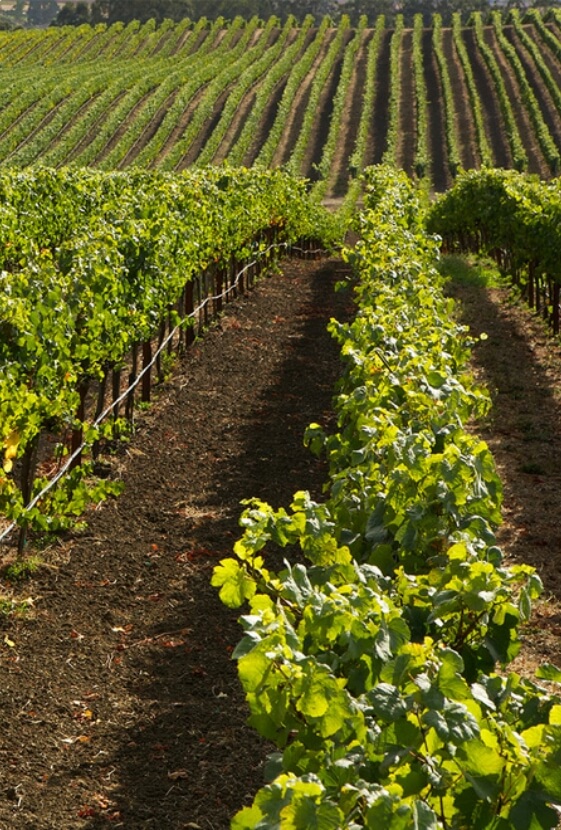Domaine Zind-Humbrecht’s Rotenberg Vineyard shares its western border with Hengst Vineyard. Its steep slope lies on a bedrock of Oligocene limestone. Due to its rich iron content, the soil has an intense brick-red color; this gives the vineyard its name, translated as “red hill.” The vineyards aspect and altitude (over 985 feet) delay ripening and therefore harvest, allowing for noble rot.
Archives: Vineyards
description
Brand Vineyard
Part of the Zind-Humbrecht Domaine, Brand Vineyard, translated to mean “land of fire,” refers to a historic fire that eroded the hillside, captured in the Turckheim archives. This Grand Cru vineyard lies entirely on a substratum known as Turckheim granite. Its steep slope is oriented south, southeast, giving the vines exceptional sun exposure while sheltering them from the north winds. Only Riesling is planted here. The vineyard covers 5.9 acres.
Hengst Vineyard
Of great historic significance, this Grand Cru belonging to Domaine Zind-Humbrecht is first mentioned in the 9th century. Located in the commune of Wintzenheim, it lies on a steep slope at an altitude of 885 to 1215 Feet. This southeast facing vineyard benefits from a dry, warm microclimate with minimal rainfall limited to roughly 640 mm per year. The soil structure is comprised of Oligocene conglomerates, marl and limestone. Zind-Humbrecht crafts exclusively Gewurztraminer from this vineyard.
Goldert Vineyard
Domaine Zind-Humbrecht’s 2.2-acre Goldert Grand Cru Vineyard is the only site in Alsace where the geological substratum is composed solely of marine oolithic limestone. The soil is deep and relatively rich. At a considerable altitude for Alsace of between 820 feet and 1150 feet, Goldert Vineyard’s slope is oriented east, southeast and enjoys an appreciable amount of sunshine (around 1370 hours from April to September). The vineyard benefits from late maturation, guaranteeing wines with well-balanced acidity.
Herrenweg Vineyard
Due to its location at the end of the Munster valley, Domaine Zind-Humbrecht’s Herrenweg Vineyard benefits from maximum sunshine, especially in the evenings with the sun setting much later. Minimal rainfall and valley winds keep the soil and the vines dry. Located on the alluvial fan of the Fecht river, a large part of Herrenweg Vineyard is made up of a clay-silty-sandy gravel-sand substratum on Vosges alluvia, Würm pebbles or loess on Würm alluvia. The soil drains well and heats up very quickly, leading to a regular and homogeneous maturation of the grapes. The warm, dry climate in consort with the soil allow this vineyard to ripen its grapes very quickly. All varieties are planted here.
Clos Windsbuhl
Domaine Zind-Humbrecht’s Clos Windsbuhl Vineyard faces south to south-east. With its average to steep slope (between 15 and 40%), the small Windsbuhl hill is at a high altitude for Alsace (around 350 m). The vines grow in a limestone substrata dense with shells (muschelkalk) and rich in clays and chalky rock. The soil is very thin in certain areas and the country rock often outcrops in the middle of the slope. It is well worth noting that the Windsbuhl Vineyard lies on a soil structure quite different from the rest of the commune.
The altitude of the vineyard coupled with Hunawihr’s tardy climate means that the Clos Windsbuhl is often one of the last of our domaine’s vineyards to be harvested. This explains the aromatic quality of the Clos’ wines and the consistent balance of acidity, a guarantee of good aging. Although often harvested late, Windsbuhl Vineyard grapes are only rarely botryitized, doubtless due to the altitude of the vineyard, but nevertheless often reach high levels of maturity.
Rangen Vineyard
Domaine Zind-Humbrecht’s 13.6-acre Grand Cru is the most southerly of Alsace’s Vineyards, located in the town of Thann. The due south-facing aspect of the vineyard increases the amount of direct sunlight, giving the vines a privileged position on the steep Rangen Hillside with its 70% gradient. Rangen is a late ripening vineyard whose exceptional exposure allows the grapes to mature slowly in October and November. The soil is composed of volcanic rocks and sedimentary sandstone. Accounts of Rangen Vineyard appear as early as the 12th and 13th centuries. One of its trademarks is the small chapel dedicated to Saint Urbain that protects its hillside. It was originally built at the end of the 15th century. Completely destroyed in the French Revolution, it was rebuilt in 1934.
Sonoma Valley AVA
Sonoma Valley AVA is in southern Sonoma County, flanked by the Sonoma Mountains to the west and the Mayacamas to the east. The climate is moderated by the Pacific Ocean’s cool summer fogs and the influence of San Pablo Bay to the south. St. Francis owns 600 acres of carefully chosen, diverse Sonoma County vineyards. The winery’s estate vineyards give it complete control over growing and production, a cornerstone to St. Francis’ quality philosophy. Each of the four estate-owned vineyards has its own soil profile and unique mesoclimate that forms a “tapestry of terroirs” carefully matched to the grape varieties grown there.
Sous Vergisson parcel within Croux vineyard
Sous Vergisson is a 7.5-acre parcel, located in the Croux vineyard just below Vergisson Rock. With an excellent south-southeast exposure, 10-35 year old vines are planted in calcareous (limestone) clay soil, which imparts finesse, complexity and volume to the wine.
Tournant de Pouilly
Situated in the northern Fuissé region, bordering on the hamlet of Pouilly, the Tournant de Pouilly vineyard of just under one hectare lies on an east-facing slope. Old vines of an average 50 years old are planted along a narrow band of pearly slabs of fossilized oyster shells that twist their way between Fuissé and Pouilly, which give this wine a linear, mineral character. There is deep, limestone-rich silt and clay containing a few stones, as well.
